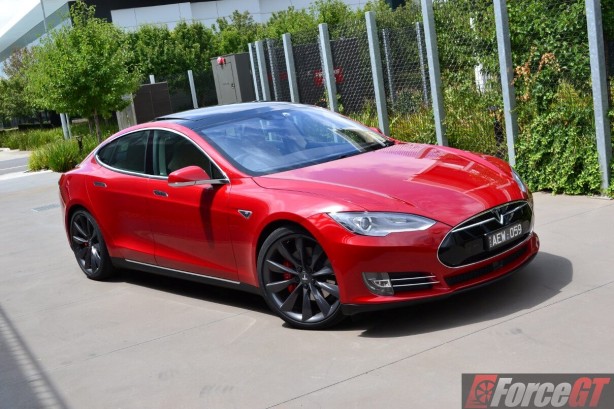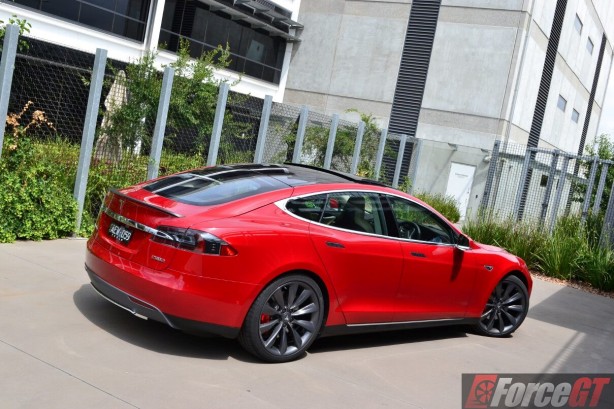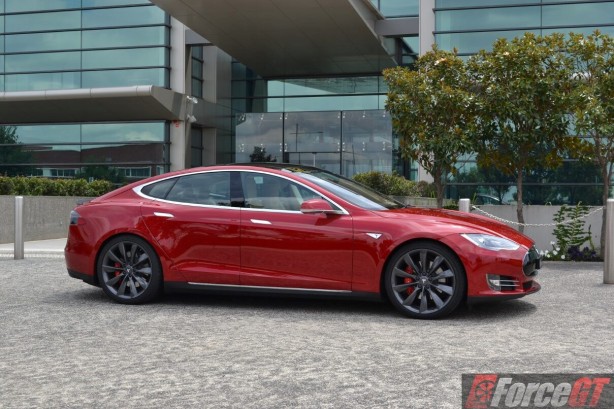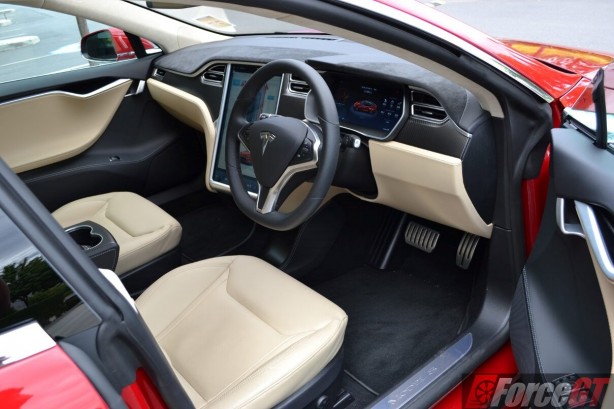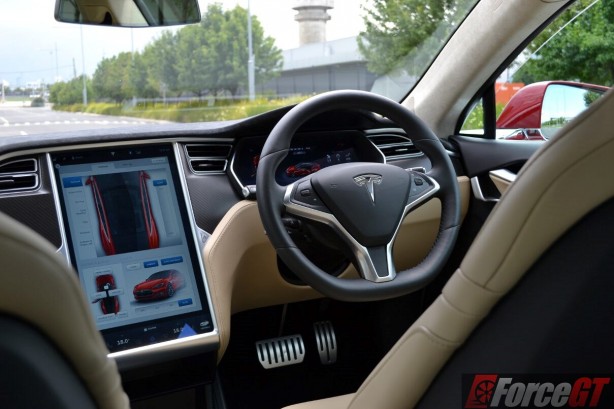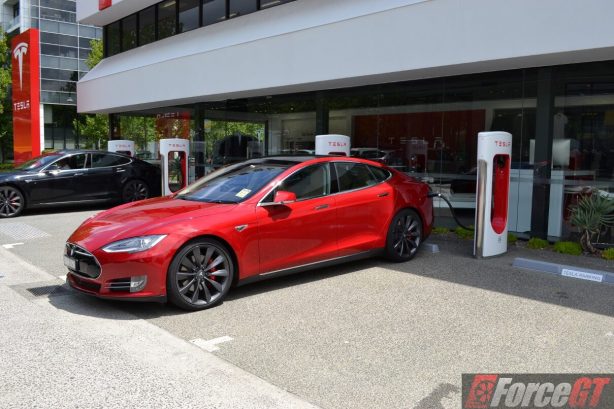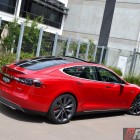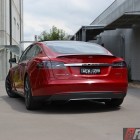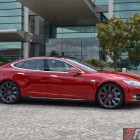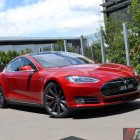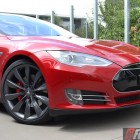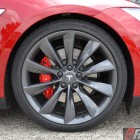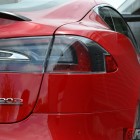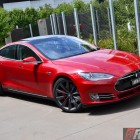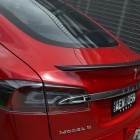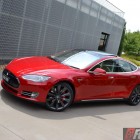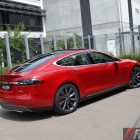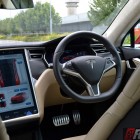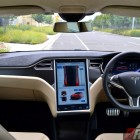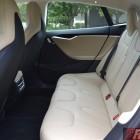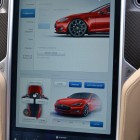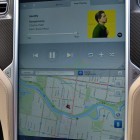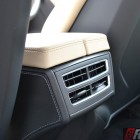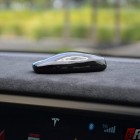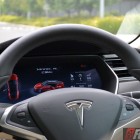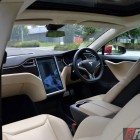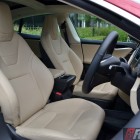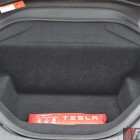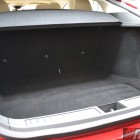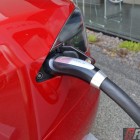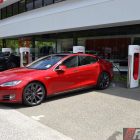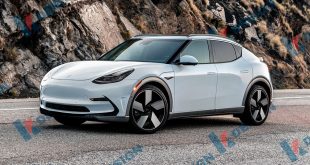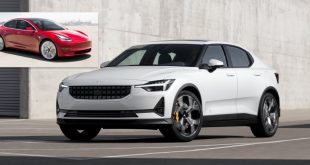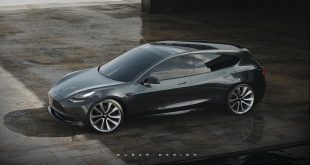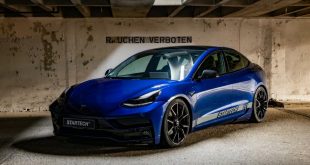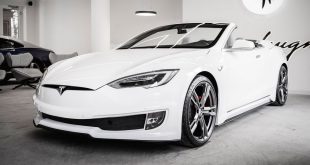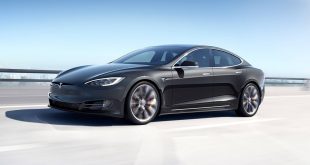Here I am sitting in the driver’s seat of a Tesla Model S P90D. Ahead of me lies an empty stretch of tarmac so straight I can almost see the curvature of the Earth. Through the gigantic 17-inch centre touch screen, I turn off Creep mode to stop the car from creeping forward when I take my foot off the brake pedal. I flick the drive mode to “Ludicrous” (yes, no joke) which, apparently, allows the Tesla to accelerate quicker than a Ferrari 458 Italia.
With both hands tightly gripping the thick-rimmed steering wheel, I take my foot off the brakes and stomp the accelerator pedal. The car launches into the horizon as the full 967Nm of torque from the electric motors is unleashed on both axles. My head pins back against the headrest as I watch the car’s digital speedometer rolls quicker than a poker machine. So fast that 100km/h happens before I could utter any swear words at the car’s ferocious acceleration.
Zero to 100km/h in 3 seconds flat. Yes, this four-door family saloon munches the century sprint quicker than a Porsche 911 Carrera, Lamborghini Huracan, Jaguar F-Type and Lexus LFA. In fact, only nine supercars in the world can sprint faster than the Tesla P90D, and this list includes elites like the Porsche 918 Spyder, LaFerrari and McLaren P1. And the best part is, the Tesla accomplishes the feat without using a drop of fuel and emitting nothing more than a fine whine from the electric motors.
The way the P90D gets up to speed is simply mind-blowing. It’s not just the launch from stationary that is savage, plant the throttle at any speed and the Tesla will surge forward like it’s riding on an endless wave of torque. When the Tesla sales rep asks you to rest your head against the headrest in a test drive, listen, because you don’t want to hurt your neck!
Like the P85D before it, the P90D features dual motors – a 375kW motor driving the rear axle and a smaller 193kW unit propelling the front axle. In essence, this makes the P90D all-wheel-drive. As if the P85D wasn’t quick enough (it does 0-100km/h in 3.2 second in “Insane” mode), the P90D adds a 90kWh battery for an even more electrifying performance, reducing 0-100km/h time to just 3 seconds. The quarter mile time of 10.9 seconds is not only close to a full second quicker than before, but also puts the P90D in the realm of super-fast cars.
But you’re paying fair old premium. Base price for the P90D comes in at $165,000 plus on roads. Add up the essential options (Ludicrous is a $15k add-on!) and you’ll be looking around the $220k mark. The one we have on test here costs a whopping $274,902 by the time you drive it on the road.
Tipping the scale at 2,200kg (a third of which comes from the batteries alone) the P90D weighs about the same as a Jeep Grand Cherokee SUV. In other words, it’s heavy. But smart designs result in a 59:49 front:rear weight distribution, which aids big time in handling. In corners, the Tesla feels fairly neutral, exhibiting mild understeer only when you get really close to its limits. There is very little body roll and grip is almost endless. Because of its heft, mid-corner bumps are barely an issue.
The steering has a nice weight to it but, like the pedals, feels numb and disconnected. Like most electric cars, braking or decelerating take a bit of getting used to. Lift off the throttle and the car slows down rather than freewheels as kinetic energy from the brakes is harvested to charge the batteries. The brakes bite hard under heavy braking but tend to be a bit inconsistent in normal driving.
Perhaps, what impresses me most about the Model S (apart from the stupendous power delivery) is the overall refinement. Because there are no firing cylinders, no intake or exhaust gases, not even gears, the full electric powertrain gives the kind of tranquillity and serenity not found in any other cars I have driven before. At any speed, the most you would get is wind and road noise. And of very low level, too, because NVH (noise, vibration and harshness) in the Tesla are remarkably well suppressed. Despite rolling on massive 21 inch wheels, the ride is also exceptionally smooth across all but the roughest surfaces.
The P90D’s air suspension (a $3,800 option) offers four selectable ride heights. At its highest setting the car will clear most bumps and steep driveways. Set to the lowest height for freeway driving, the car hunkers down with almost no gap between the tyres and the wheel fenders.
Charging the P90D is as easy as charging your mobile phone. One end of the charge lead connects to the car and the other end plugs into any power socket in your home. A full charge through a domestic 10A outlet will take north of 6 hours. But take it to a free-to-use Tesla Supercharger charge point and a full replenish takes just 50 minutes.
Depending on how you drive, the P90D is capable of up to 505km in range from a single charge. And if you live in Sydney or Melbourne, Tesla claims the next Supercharger station is always within reach before you run out of juice. Yes, you can even drive from Melbourne to Sydney as there are three rural Supercharger stations between the two cities.
Inside, the Tesla feels very different compared to other American cars I have sat in. It’s simple, elegant and feels premium, though fit and finish is still not up to European or Japanese standards.
But more importantly, the Tesla’s interior radiates a very unique type of luxury. If these words make your heart skip a beat – Google, Apple, Facebook, Amazon and eBay – then you will love the Tesla’s cabin. Those companies and Tesla hail from an area in southern California called Silicon Valley – home to some of the world’s most innovative technology companies. And the vibe is all reflected in the Model S’ tech-infused interior.
Central to the spacious cabin is of course the centre touchscreen which looks like a sized-up iPad. Everything, and I mean everything, is controlled through this screen, including the sunroof, headlights and the release for the trunk, I mean boot.
The touchscreen dispenses super high resolution graphics and is very easy to use. At least to a tech freak like myself. Google maps show up the entire 17 inch screen if you wish. You can pan, swipe and pinch on the screen just like you would with your smart phone. With a sim card, you can also stream your favourite music from Spotify.
The instrument panel is made up of another digital display and serves up various driving information. But because there is no engine, there are no dials. Instead, the display presents real-time graphical projection of what’s around the car – line markings on the road and other vehicles – using data gathered from the car’s sensors and cameras.
For a bit of eye candy? No, because the P90D is equipped with Autopilot; Tesla’s semi-autonomous driving feature which can drive, brake and steer the car for you under certain conditions. It can even change lane automatically when you indicate and detect speed signs in real time. Believe me when I say this car can literally drive from Melbourne to Sydney on the Hume freeway all by itself!
Five adults would sit comfortably in the Tesla’s beautifully crafted seats, with both rows of occupants getting plenty of legroom. Taller rear passengers will find headroom a premium due to the sloping roof line.
In terms of practicality, the Model S is second to none. In addition to the rear boot, the bonnet opens up to a second smaller cargo bay (there’s no engine, remember?), which can swallow up a couple of small suitcases.
Verdict
The fact that the Tesla Model S P90D is able to beat a supercar to the next set of lights is enough to change the perception of electric cars. Yes, they are now mouth-wateringly fast.
Add the fact that you can now drive on full electric propulsion for over 500km without charging and you may think this Tesla is the future.
Well it is. We just have to wait for the infrastructure to catch up. Given enough Supercharger stations, I don’t see why anyone wouldn’t drive one.
Design & Comfort: 9.0/10
Performance & Handling: 9.0/10
Quality: 8.0/10
Economy: 8.5/10
Features & Equipment: 8.0/10
Pros
- Supercar acceleration, remarkable handling
- Refinement
- Cool factor
- High-tech interior
Cons
- Expensive
- Not enough Supercharger stations
Tesla Model S P90D price and specification
| Price: | Excl. on-roads: $165,000; As tested: $218,600 Total price on-road as tested: $274,902 |
| Warranty: | 8-year unlimited km battery and drive |
| Drive: | Electric motors (dual) 193kW front, 375kW rear; 375kW total output (397kW in Ludicrous mode), 967Nm |
| Range (full charge) | 505km |
| 0-100km/h: | Claimed: 3.0 seconds; Tested: 3.1 seconds |
| Top speed: | 250km/h |
| Body: | 4-door sedan; 5 seats |
| Safety: | 5-star ANCAP |
| Dimensions: | Length: 4,970, Width: 1,964, Height: 1,435, Wheelbase: 2,960 |
| Kerb Weight | 2,187 kg |
Competitors:
Porsche Panamera, Maserati Quattroporte, BMW 6 Series GranCoupe, Mercedes-Benz CLS, Audi S7
 ForceGT.com Car News, Car Reviews, Video Reviews, Tuning and much more.
ForceGT.com Car News, Car Reviews, Video Reviews, Tuning and much more. 